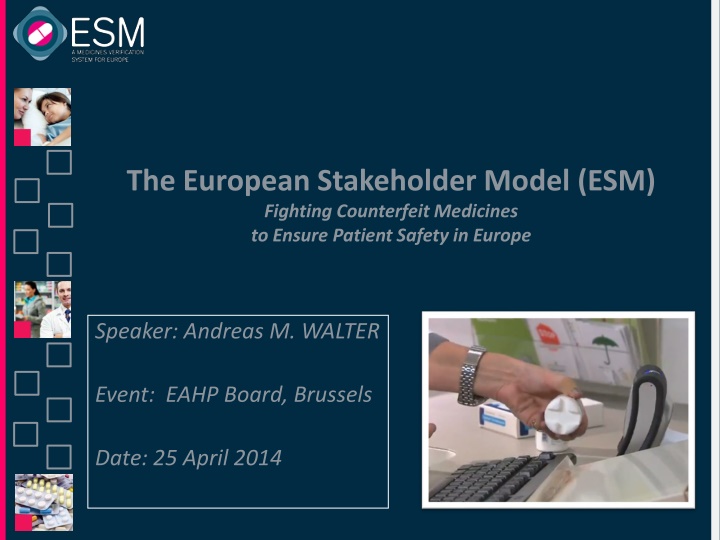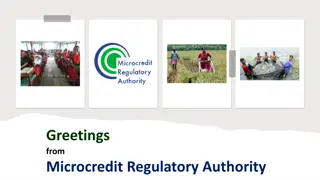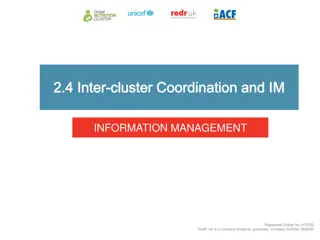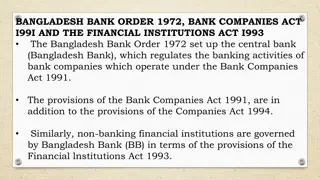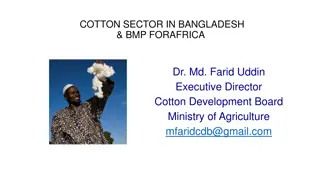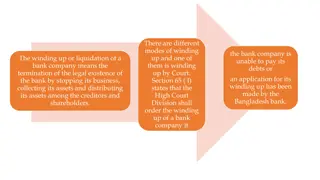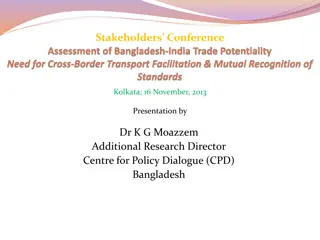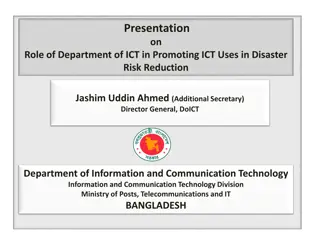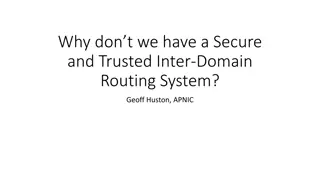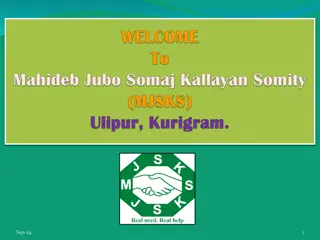Inter-Operability of e-GP System in Bangladesh
The inter-operability of the e-GP system in Bangladesh, managed by Md. Faruque Hossain DG at CPTU IMED, Ministry of Planning, focuses on effectively linking multiple systems and organizations transparently. This ensures high levels of transparency, efficiency, security, and error-free data, reducing transaction times and enhancing process speed. Major players include Procuring Agencies, Tenderers, e-GP Administrator, Operations Partners, Development Partners, and more. Scopes of inter-operability cover areas like budget integration, national ID verification, trade body enrollment, and collaboration with security agencies and financial institutions.
Download Presentation

Please find below an Image/Link to download the presentation.
The content on the website is provided AS IS for your information and personal use only. It may not be sold, licensed, or shared on other websites without obtaining consent from the author.If you encounter any issues during the download, it is possible that the publisher has removed the file from their server.
You are allowed to download the files provided on this website for personal or commercial use, subject to the condition that they are used lawfully. All files are the property of their respective owners.
The content on the website is provided AS IS for your information and personal use only. It may not be sold, licensed, or shared on other websites without obtaining consent from the author.
E N D
Presentation Transcript
The European Stakeholder Model (ESM) Fighting Counterfeit Medicines to Ensure Patient Safety in Europe Speaker: Andreas M. WALTER Event: EAHP Board, Brussels Date: 25 April 2014
1. OVERVIEW 2. THE ESM IN PRACTICE 3. ESM GOVERNANCE 4. TIMELINE 5. ESM & PHARMACISTS 6. EXCURSUS: FMD & UNIT DOSE CODING
The Directive Safety Features What Will Be Decided by Implementing Measures? What Does the Directive Mandate? Safety features that enable relevant persons to verify authenticity identify individual packs Tamper evidence Characteristics & technical specifications of the unique identifier Criteria for the risk assessments & process for notification of products included All Rx included, all OTCs excluded. some exceptions based on a risk assessment Extent and modalities of verification of the safety features to ensure the verification of authenticity of each dispensed pack Governments can use the system for reimbursement and/or pharmacovigilance purposes Establishment (including accessibility) of the repositories MAHs will pay for the repositories systems 3
Result of COMs impact assessment Conclusions In summary, the Commission will propose: Harmonisation of the composition of the number and the data carrier Systematic verification of the safety features at the dispensing point and risk-based verification by wholesale distributors Establishment and management by stakeholders with supervision by the relevant competent authorities Source EC presentation at 13thEGA regulatory and scientific affair conference, 24 Jan 2014 05 Feb 2014 4
ESM is Stakeholders Answer to FMD 2011 EU Falsified Medicines Directive (FMD) defines measures to increase reliability of the medicinal supply chain Manufacturers to apply safety features to allow verification of authenticity and identification of individual packs Repository systems must be established to house information on safety features Costs for repository system to be borne by Manufacturing Authorisation Holders ESM partners are developing an effective system that will Meet requirements of the FMD Provide high level of safety for patients Be cost-effective Integrate effectively into existing supply chain processes 5
What is the ESM? The ESM is A European end-to-end system enabling medicines to be verified at point of dispensing to the patient Developed and governed by the stakeholders who will use it in day-to-day operations. Key takeaways: The ESM Is a tried-and-tested European approach Ensures safe access to medicines Is a cost-efficient and interoperable solution Is stakeholder-run on a non-profit basis Is now ready for first roll-out step 6
Who Are The ESM Partners? EAEPC European Assoc. of Euro-Pharmaceutical Companies (Parallel Distributors) European Federation of Pharmaceutical Industries and Associations GIRP European Association of Pharmaceutical Full-line Wholesalers Pharmaceutical Group of the European Union EFPIA PGEU
Data Carrier and Contents ESM uses 2D Data Matrix code, developed to internationally recognised standards (GS1) Four key data elements Manufacturer Product Code Randomised Unique Serial Number Expiry Date Batch Number Example Product #: 09876543210982 Batch: A1C2E3G4I5 Expiry: 140531 S/N: 12345AZRQF1234567890 On 31 Jan. 2014, European Commission confirmed usage of 2D Data Matrix Code with four data elements plus nat l reimbursement number. 9
Point-of-Dispense Verification Process Pharmaceutical Manufacturer Pharmacist Wholesaler Patient Wholesaler Product Flow Unique Verification upon Dispense to Patient Serialisation with Random Numbers Risk-based Verification 2D Data Matrix Code on 2ndPack GTIN Batch Medicines Verification Repository Upload Number Authenticate Number Expiry S/N On 31 Jan. 2014, European Commission confirmed to proceed with Point-of-Dispensing verification concept. 10
European Medicines Verification System (EMVO) European Hub Parallel Distributor Pharmaceutical Manufacturer National Blueprint System 1 National Blueprint System n securPharm (Germany) National System n Pharmacy Wholesaler Pharmacy Wholesaler Pharmacy Wholesaler Wholesaler Pharmacy Parallel Distributor: mandatory verification + data upload Manufacturer: data upload + voluntary verification Periodic cross-region update Pharmacy: mandatory verification Wholesaler: voluntary verification 11
The benefit of Hub and Blueprint systems European Hub European Hub Secures cross-border trade Provides cost savings for connecting manufacturers Ensures interoperability between national systems Supports establishment of standard interfaces National System (Blueprint) National Blueprint system (nBPS) - optional Allows national stakeholders to join the EMVS without the need of building a separate own national system Based on a standard national verification system providing all necessary functionality Fewer, but bigger (aggregate) systems are less costly than many (individual) smaller systems Particularly attractive for Member States with no system/ infrastructure in place 05 Feb 2014 12
Testing and Evolution Swedish pilot project (Sep 2009 - Feb 2010) 25 pharmacies in greater Stockholm area.180 dispensing points 25 products. 110,000 packs. 14 manufacturers Key findings Allows pharmacists to work at normal pace Is customised to existing workflows Is integrated into existing pharmacy software Pharmacists and wholesalers are keen to get expiry date and batch number in machine-readable form In 2014, ESM partners continue to work on national system interface with securPharm project in Germany 13
Who should be member of the governance organisation ? Each relevant market partner constituency should be represented: Pharmacists Wholesalers Marketing Authorisation Holders (branded & generic products) Parallel traders supervision by competent authorities 05 Feb 2014 15
Governance is required at European and National level EU Hub European Medicines Verification Organisation (EMVO) will Govern EU Hub Set standards for the system Conclude agreements with NMVOs EMVO Board Governance EMVO System management IT provider to EMVO System operation National stakeholders govern national systems through National Medicines Verification Organisation (NMVO) Cooperation agreements NMVO Board NMVO Board Blueprint system to be governed nationally, but managed by EMVO NMVO / EMVO NMVO IT provider to EMVO IT provider to NMVO supervision by competent authorities National System (Blueprint) National System On 31 Jan. 2014, European Commission confirmed stakeholder governance with system access and supervision of National Competent Authorities. 16
The EMVS: Result of a Long Evolution 2010 Involvement of PGEU, GIRP, EAEPC 2015-2018 Introduction of medicines verification systems in EU Member States Provision of coded products 2006 EFPIA s initial activities for traceability of medicines 2014 European Hub in operation (Q1), Liaison with securPharm (Q3) 2012 Stakeholders Memorandum of Understanding` 2009 / 2010 EFPIA pilot in Sweden 2008 - 2013 System design 2013 - 2015 System build 2015 - 2018 Ramp up 2007 2014 2018 July 2011 Publication of FMD Q1 2015 exp. Publication of Delegated Acts 18
Pharmacies connect through their existing SW systems nBPS provides standard interfaces to allow users SW suppliers to connect and use standard functional modules Verify pack Dispense pack / undo dispense Decommission pack / undo decommission Export pack (out of EU or for parallel trade) Verify multiple packs (restricted use to prevent overload) Pharmacy workflow is not determined by nBPS, but by pharmacy SW 20
Integration of verification into pharmacy work flow: Example EU Hub connection National Medicines Verification System Dispense Decommission Verify Multi Verif. Interface Interface Goods receipt Dispense pack Check pack Pharmacy Software 21
FMD and UDC Scope: Implementation of Data Carriers on primary packaging for Pharmaceutical Products Hurdles, e.g.: Formally no direct regulatory link Change in primary pack format could result change/increase in secondary pack formats Increase in investments New machinery IT Authority approvals if change in Artworks and design of pack and contents of the labeling BUT 23
FMD and UDC ESM asks for 2D Matrix ESM requires 4 code elements THEREFORE While supporting ESM principles, two step approach conceivable: First step: Primary package contains a 2D Matrix code or linear barcode containing a GTIN only. Second step: Primary package contains a 2D Matrix code containing GTIN, Expiry Date and Batch Number (codification) . 24
ensuring patients have access to safe medicines www.esm-system.eu
